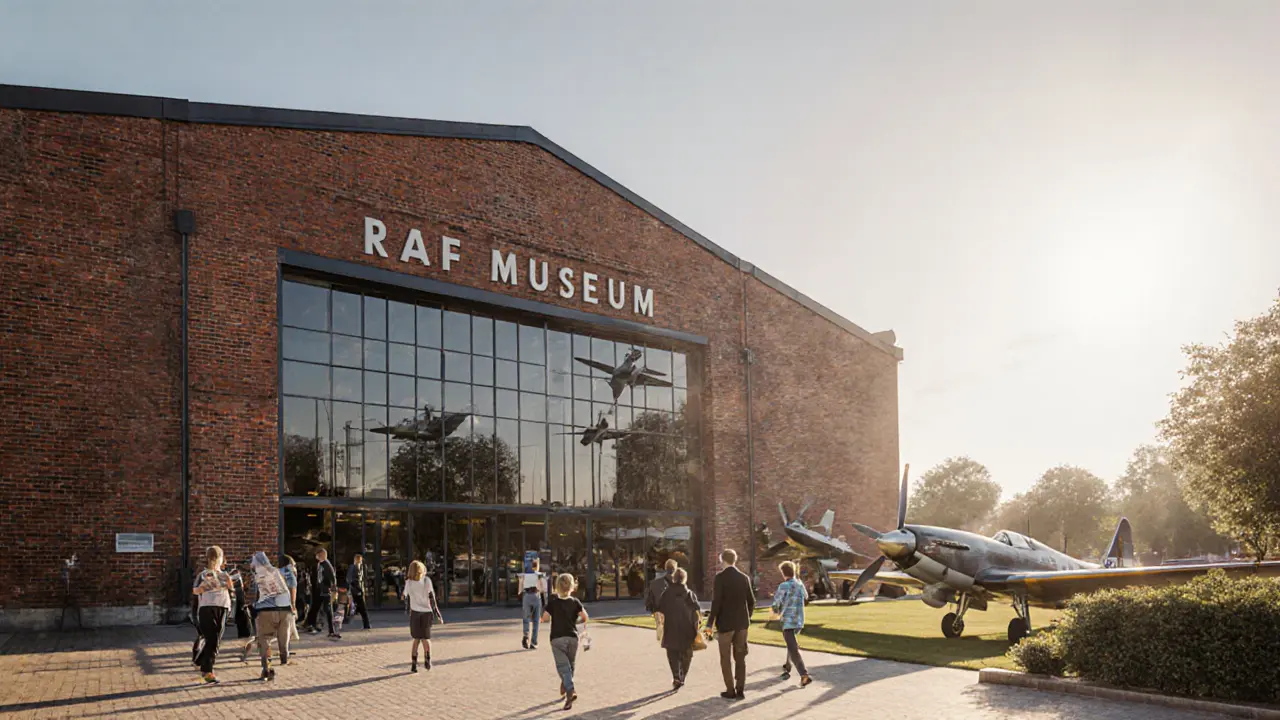Exploring Lifestyle and Learning at the RAF Museum London
Imagine a place where history, technology, and personal growth collide - that’s the vibe you get at the RAF Museum London. It’s not just a collection of old aircraft; it’s a living classroom that lets you walk through the story of flight while picking up life‑skills along the way. In this guide we’ll unpack the museum’s origins, the hands‑on experiences it offers, how it stacks up against other London attractions, and what you can expect on a typical visit. By the end you’ll know exactly why a trip here fits right into a modern lifestyle focused on curiosity and continuous learning.
Understanding the Basics of the RAF Museum London
Origins and History
The RAF Museum began in 1972 as a modest exhibition space at the former Royal Aircraft Establishment in Farnborough. In 2001 it moved to its current home on the historic Royal Air Force site at Hendon, an area that once buzzed with fighter squadrons defending London during World War II. The museum’s mission expanded from simply preserving aircraft to educating the public about the broader impact of aviation on society.
Core Principles or Components
Four pillars define the museum’s approach:
- Authentic Historic Aircraft restorations that let visitors see the metal up close.
- Immersive Interactive Exhibits ranging from flight simulators to VR cockpit experiences.
- Structured Educational Programs for school groups, families, and adult learners.
- Community‑focused events that tie aviation heritage to contemporary lifestyle themes, such as sustainability in air travel.
How It Differs from Related Museums
While the Imperial War Museum and the Science Museum also showcase technology, the RAF Museum hones in on the human element of flight - the pilots, engineers, and ground crew whose decisions shaped modern life. Below is a quick comparison:
| Museum | Key Focus | Interactive Offerings | Dedicated Education Path |
|---|---|---|---|
| RAF Museum London | Aviation history & RAF legacy | Flight sims, VR cockpits, aircraft interior tours | Curriculum‑aligned school packs, teacher workshops |
| Imperial War Museum | Military conflicts overall | Audio‑visual war rooms, artifacts | History‑focused school trips |
| Science Museum | Science & innovation | Hands‑on labs, digital displays | STEM workshops and labs |
Who Can Benefit from the RAF Museum?
Anyone curious about how flight reshaped everyday life can find value here. Families love the kid‑friendly flight simulators, teens get a taste of engineering through engine cut‑away displays, and adults often leave with fresh perspectives on leadership and teamwork drawn from RAF stories. Even professionals in logistics or design discover cross‑industry insights by observing aircraft production workflows.
Benefits of Visiting the RAF Museum for Lifestyle and Learning
Boosting Curiosity and Critical Thinking
Seeing real aircraft up close forces you to ask "how?" and "why?" - questions that kick‑start critical thinking. Studies from educational bodies show that tangible learning experiences improve memory retention up to 30% compared with textbook study alone.
Developing Soft Skills
Many exhibits highlight decision‑making under pressure, teamwork in squadron missions, and the discipline required to maintain aircraft. These narratives translate into real‑world soft skills: communication, resilience, and strategic planning - all valuable for personal and professional growth.
Emotional Well‑Being Through Storytelling
Human stories behind each plane - pilots who survived the Battle of Britain, engineers who built the jet engine - provide a sense of connection. Engaging with these narratives can lift mood and foster a feeling of belonging to a larger historical continuum.
Practical Applications in Everyday Life
Lessons from aviation safety, such as check‑lists and risk assessment, are directly applicable to home projects, health routines, or even budgeting. Below is a snapshot of key takeaways:
| Benefit | Description | Impact on Daily Life |
|---|---|---|
| Critical Thinking | Analyzing aircraft mechanics | Better problem solving at work |
| Teamwork Insight | Squadron coordination stories | Improved collaboration with friends/family |
| Safety Mindset | Checklist culture in aviation | Reduced accidents at home |
| Historical Perspective | Understanding technological evolution | Informed decisions about tech adoption |
What to Expect When Visiting the RAF Museum
Setting or Context
The museum sits on the former Hendon airfield, just a short tube ride from Golders Green (Northern line). Inside, the layout guides you chronologically - from early biplanes to modern jets - with spacious galleries, cafés, and even a garden where vintage aircraft are displayed outdoors.
Key Processes or Steps
- Collect your tickets online - it saves a 10‑minute queue.
- Grab a map at the welcome desk; note the "Interactive Zone" and "Education Hub".
- Start with the historic hangar, then move to the flight‑sim area for a hands‑on taste.
- Take a short break at the café; try the “Pilot’s Peanut Butter” toast - a quirky nod to the museum’s foodie side.
- Finish with the special exhibition or attend a scheduled talk.
Customization Options
Visitors can book tailored tours: a family‑focused adventure, a deep‑dive for aviation students, or a corporate team‑building session that uses aircraft case studies to spark discussion.
Communication and Preparation
If you’re joining a guided tour, arrive 5‑10 minutes early so the guide can brief you on safety (no flash photography near certain exhibits) and answer any accessibility queries.

How to Make the Most of Your Visit
Setting Up for Success
Wear comfortable shoes - the galleries are spread across two floors with a few stairs. Bring a reusable water bottle; there are refill stations throughout.
Choosing the Right Resources
Before you go, check the museum’s website for any temporary exhibitions that match your interests - the "Women of the RAF" showcase often runs in spring. Download the free app; it adds AR overlays to certain aircraft, turning a simple photo into a mini‑lecture.
Step‑by‑Step Guide to a Perfect Day
- Plan your transport: Use the TfL journey planner to pick the quickest tube route. The museum offers a free bike rack if you prefer cycling.
- Book tickets early: Online tickets unlock a 5% discount for students and seniors.
- Start with the heritage hall: Scan the QR codes for audio snippets narrated by former RAF pilots.
- Engage the interactive zone: Spend at least 20 minutes on the flight simulator - it’s calibrated for all skill levels.
- Join a workshop (if scheduled): Topics range from "Basic Aerodynamics" to "Aircraft Preservation Techniques".
- Wrap up with reflection: Write a quick note in the visitor book about what surprised you most - it helps cement learning.
Tips for First‑Timers and Groups
Family groups should split up: kids love the “Kids Flight Club” while adults might prefer the engineering deep‑dive. If you’re with a partner, the museum’s rooftop café offers a quiet view of the historic runway - ideal for a post‑visit chat.
FAQ: Common Questions About the RAF Museum
What can I expect during a typical visit?
A typical visit lasts 2‑3hours and blends self‑guided exploration with optional interactive stations. You’ll walk through historic aircraft displays, try a flight simulator, and can join a scheduled talk or workshop. The museum is designed for all ages, so you can tailor the experience to your interests.
Are there any age restrictions for the interactive exhibits?
Most interactive stations are suitable for visitors 8years and older. Younger kids can enjoy the "Kids Flight Club" where staff guide them through simplified cockpit mock‑ups. All activities are supervised and comply with safety standards.
How does the RAF Museum differ from the Imperial War Museum?
The Imperial War Museum covers all military conflicts and their societal impact, while the RAF Museum zeroes in on aviation and the Royal Air Force’s role. This focus brings more hands‑on flight experiences, aircraft restoration stories, and aviation‑specific education programmes.
Can I host a private event or workshop at the museum?
Yes - the museum offers private hire of its education hall and exclusive tours for corporate teams, birthday parties, or community groups. Contact the Events Team through the website’s "Book a Session" form to discuss capacity, catering, and tailored content.
Is the museum accessible for visitors with mobility needs?
The venue is wheelchair‑friendly, with ramps, lifts, and accessible restrooms. If you need additional assistance, email the accessibility officer in advance so they can arrange a guide or provide any required materials in alternative formats.
Safety and Ethical Considerations
Choosing Qualified Guides and Resources
All museum educators hold relevant qualifications in history, aerospace engineering, or museum studies. Look for badges that indicate "Qualified Aviation Educator" or similar credentials when selecting a private guide.
Safety Practices
Interactive exhibits enforce a strict no‑food‑or‑drink rule near aircraft to protect delicate surfaces. Flight simulators include a short safety briefing before you start - it’s quick but essential.
| Practice | Purpose | Example |
|---|---|---|
| Hand Hygiene | Preventing grime on controls | Use provided sanitizer before simulators |
| Photo Policy | Protecting artefacts | No flash photography in the restoration workshop |
| Accessibility Requests | Inclusive experience | Pre‑book wheelchair assistance |
Setting Boundaries
If you’re joining a workshop, feel free to ask the facilitator to pause for questions - the environment encourages curiosity, not passive watching.
Contraindications or Risks
People prone to motion sickness might find the high‑fidelity flight simulators a bit intense. The museum offers a “cabin‑crew” mode with reduced motion for such visitors.

Enhancing Your Experience
Adding Complementary Practices
Pair your museum trip with a short mindfulness walk in the nearby Hendon Park. Reflecting on the engineering marvels you just saw can deepen the sense of awe and help the information stick.
Collaborative or Solo Engagement
Solo visitors often appreciate the quiet of the aircraft restoration bay, while groups benefit from the team‑building challenges built into the simulators. Choose what matches your mood.
Using Tools or Props
The museum’s app offers an augmented‑reality overlay that shows internal engine components when you point your phone at a displayed jet. It’s a cheap, high‑tech way to turn a static display into a dynamic lesson.
Regular Engagement for Benefits
Consider a monthly “Aviation Night” where the museum opens after hours for themed talks. Consistent exposure keeps the learning fresh and builds a community of fellow enthusiasts.
Finding Resources or Experts
Researching Qualified Experts
Look for presenters who hold a degree in Aeronautical Engineering or a recognized museum studies certification. Their bios are usually listed on the museum’s staff page.
Online Guides and Communities
Websites like the Royal Aeronautical Society’s “Aviation Learning Hub” and forums such as “AirlineHistory.com” provide deeper dives into topics you might have only skimmed at the museum.
Legal or Cultural Considerations
Some displays include aircraft used in former colonies; the museum provides context to avoid glorifying conflict. Being aware of these narratives enriches the experience and respects diverse perspectives.
Resources for Continued Learning
- Book: "The Rise of British Aviation" by J. Harris (2023 edition).
- Documentary series: "Wings of Britain" - BBC, Season2.
- Online course: "Aerospace Fundamentals" - offered by Coursera in partnership with the University of Manchester.
Conclusion: Why the RAF Museum Is Worth Exploring
A Path to Lifelong Learning
The RAF Museum turns a day out into a mini‑university session, blending history, technology, and personal development. Whether you’re after a family adventure, a new hobby, or fresh inspiration for work, the museum delivers concrete takeaways you can apply right away.
Try It Mindfully
Plan your visit, engage with the interactive stations, and take a moment to reflect on each story. If you’re unsure where to start, the Education Hub’s introductory tour is a safe bet.
Share Your Journey
Did you discover a favorite aircraft? Have a tip for first‑timers? Drop a comment below or tag us on social media - we love hearing how the experience shaped your lifestyle.
RAF Museum London offers more than history; it’s a springboard for curiosity, skill‑building, and community connection. Ready to book your tickets?
Some links may be affiliate links, but all recommendations are based on research and quality.

